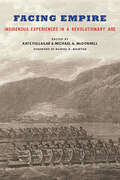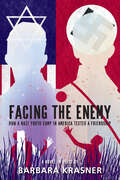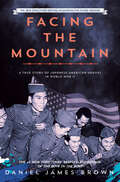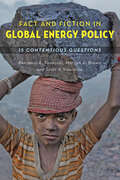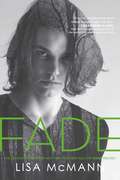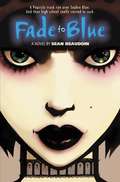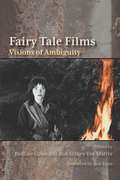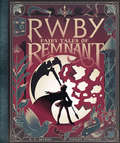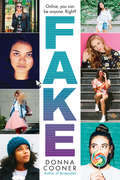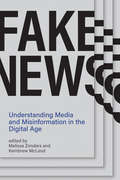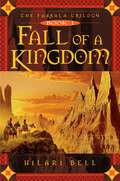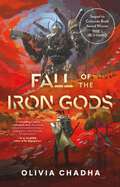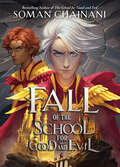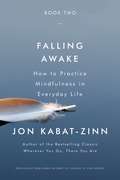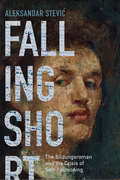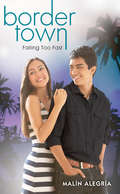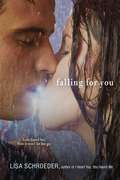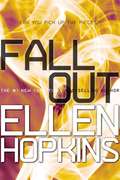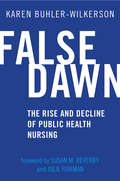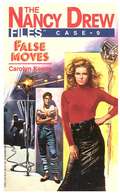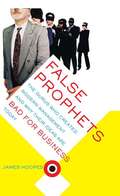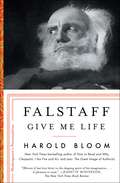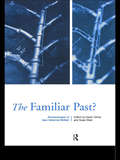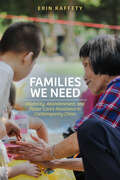- Table View
- List View
Facing Empire: Indigenous Experiences in a Revolutionary Age
by Kate Fullagar and Michael A. McDonnellA major reframing of world history, this anthology interrogates eighteenth- and nineteenth-century European imperialism from the perspective of indigenous peoples.Rather than casting indigenous peoples as bystanders in the Age of Revolution, Facing Empire examines the active roles they played in helping to shape the course of modern imperialism. Focusing on indigenous peoples’ experiences of the British Empire, the volume’s comparative approach highlights the commonalities of indigenous struggles and strategies across the globe.Facing Empire charts a fresh way forward for historians of empire, indigenous studies, and the Age of Revolution. Covering the Indian and Pacific Oceans, Australia, and West and South Africa, as well as North America, this book looks at the often misrepresented and underrepresented complexity of the indigenous experience on a global scale.Contributors: Tony Ballantyne, Justin Brooks, Colin G. Calloway, Kate Fullagar, Bill Gammage, Robert Kenny, Shino Konishi, Elspeth Martini, Michael A. McDonnell, Jennifer Newell, Joshua L. Reid, Daniel K. Richter, Rebecca Shumway, Sujit Sivasundaram, Nicole Ulrich
Facing the Enemy: How a Nazi Youth Camp in America Tested a Friendship
by Barbara KrasnerWhat do you do when your best friend becomes the enemy? Growing up in Newark, NJ, in the 1930s, Tommy Anspach and Benjy Puterman have always done everything together. It never mattered that Benjy was Jewish and Tommy was of German descent. But as Adolph Hitler and his Nazi party comes to power in Germany and war brews in Europe, everything changes. Tommy is sent to Camp Nordland, a Nazi youth camp for German Americans, where he quickly learns that Jews are the enemy. Heartbroken by the loss of his friend, Benjy forms a teen version of the Newark Minutemen, an anti-Nazi vigilante group, all the while hoping that Tommy will abandon his extremist beliefs. Will Benjy and Tommy be able to overcome their differences and be friends again?Based on real-life events and groups like the Newark Minutemen and the pro-Nazi German American Bund, this daring novel-in-verse reveals the long history of American right-wing extremism, and its impact on the lives of two ordinary teens.
Facing the Mountain (Adapted for Young Readers): A True Story of Japanese American Heroes in World War II
by Daniel James BrownAdapted for young readers from the New York Times bestseller by Daniel James Brown, Facing the Mountain is the remarkable true story of three brave Japanese American soldiers who fought for the United States during World War II while facing discrimination at home. Perfect for readers of The Boys in the Boat.After the Japanese military bombed Pearl Harbor in 1941, Japanese Americans became the subject of racism and discrimination within the United States. Many were rounded up and put in concentration camps. But even while this was happening, there were many Japanese American soldiers who fought to ensure that all Americans were safe during the biggest conflict in world history.Facing the Mountain is the story of three Japanese American soldiers: Rudy Tokiwa, Fred Shiosaki, and Kats Miho, who volunteered for the 442nd Regimental Combat Team to fight for their country in World War II. The book covers the three soldiers' deployment to Europe and the struggles of their families back home. Woven throughout is the chronicle of Gordon Hirabayashi, one of a cadre of patriotic resisters who stood up against the government in defense of their own rights.Equal parts riveting war story, resisitance history, and courtroom drama, Facing the Mountain is a fascinating and impeccably researched book that will captivate young readers. Includes black and white photos and backmatter.
Fact and Fiction in Global Energy Policy: Fifteen Contentious Questions
by Benjamin K. Sovacool Marilyn A. Brown Scott V. ValentineA balanced examination of global energy issues.Energy sustainability and climate change are two of the greatest challenges facing humankind. Unraveling these complex and interconnected issues demands careful and objective assessment. Fact and Fiction in Global Energy Policy aims to change the prevailing discourse by examining fifteen core energy questions from a variety of perspectives, demonstrating how, for each of them, no clear-cut answer exists.Is industry the chief energy villain? Can we sustainably feed and fuel the planet at the same time? Is nuclear energy worth the risk? Should geoengineering be outlawed? Touching on pollution, climate mitigation and adaptation, energy efficiency, government intervention, and energy security, the authors explore interrelated concepts of law, philosophy, ethics, technology, economics, psychology, sociology, and public policy.This book offers a much-needed critical appraisal of the central energy technology and policy dilemmas of our time and the impact of these on multiple stakeholders.
Fade (Wake)
by Lisa McMannSOME NIGHTMARES NEVER END. For Janie and Cabel, real life is getting tougher than the dreams. They're just trying to carve out a little (secret) time together, but no such luck. Disturbing things are happening at Fieldridge High, yet nobody's talking. When Janie taps into a classmate's violent nightmares, the case finally breaks open -- but nothing goes as planned. Not even close. Janie's in way over her head, and Cabe's shocking behavior has grave consequences for them both. Worse yet, Janie learns the truth about herself and her ability -- and it's bleak. Seriously, brutally bleak. Not only is her fate as a dream catcher sealed, but what's to come is way darker than she'd feared....
Fade to Blue
by Sean BeaudoinSophie Blue started wearing a black skirt and Midnight Noir lipstick on her last birthday. It was also the day her father disappeared. Or spontaneously combusted. Which is sort of bad timing, since a Popsicle truck with tinted windows has started circling the house. Kenny Fade is a basketball god. His sneakers cost more than his Jeep. He's the guy all the ladies (and their mommas) want. Bad. Sophie Blue and Kenny Fade don't have a thing in common. Aside from being reasonably sure they're losing their minds.
Fairy Tale Films: Visions of Ambiguity
by Greenhill, Pauline; Matrix, Sidney EveIn this, the first collection of essays to address the development of fairy tale film as a genre, Pauline Greenhill and Sidney Eve Matrix stress, "the mirror of fairy-tale film reflects not so much what its audience members actually are but how they see themselves and their potential to develop (or, likewise, to regress)." As Jack Zipes says further in the foreword, “Folk and fairy tales pervade our lives constantly through television soap operas and commercials, in comic books and cartoons, in school plays and storytelling performances, in our superstitions and prayers for miracles, and in our dreams and daydreams. The artistic re-creations of fairy-tale plots and characters in film—the parodies, the aesthetic experimentation, and the mixing of genres to engender new insights into art and life—mirror possibilities of estranging ourselves from designated roles, along with the conventional patterns of the classical tales.” Here, scholars from film, folklore, and cultural studies move discussion beyond the well-known Disney movies to the many other filmic adaptations of fairy tales and to the widespread use of fairy tale tropes, themes, and motifs in cinema.
Fairy Tales of Remnant: An AFK Book (Rwby Ser.)
by E. C. MyersDon't miss this gorgeous, gift-worthy collection of RWBY fairy tales, straight from the show writers and E.C. Myers!Fans of Rooster Teeth's hit animated series RWBY will want to pore over every page of this gorgeously illustrated collection of twelve short fairy tales. In addition to classic tales from the show, such as "The Story of the Seasons" and "The Tale of the Two Brothers," readers can immerse themselves in eight never-before-told stories from RWBY's show writers. Vibrant artwork throughout completes the collection, offering new insights into the strange, beautiful, and dangerous world of Remnant.This deluxe edition also happens to be the personal copy of Professor Ozpin, complete with a foreword from the former Beacon headmaster himself. Fans won't want to miss this must-have collection, sure to reveal more secrets about RWBY and the stunning world of the show!
Faith, Race, and the Lost Cause: Confessions of a Southern Church
by Christopher Alan GrahamFaith, Race, and the Lost Cause is a new history of Richmond’s famous St. Paul’s Episcopal Church, attended by Robert E. Lee and Jefferson Davis during the Civil War and a tourist magnet thereafter. Christopher Alan Graham’s narrative—which emerged out of St. Paul’s History and Reconciliation Initiative—charts the congregation’s theological and secular views of race from the church’s founding in 1845 to the present day, exploring the church’s complicity in Lost Cause narratives and racial oppression in Richmond.Graham investigates the ways that the actions of elite white southerners who imagined themselves as benevolent—liberal, even—in their treatment of Black people through the decades obscured the actual damage to Black bodies and souls that this ostensible liberalism caused. Placing the legacy of St. Paul’s self-described benevolent paternalism in dialogue with the racial and religious geography of Richmond, Graham reflects on what an authentic process of recognition and reparations might be, drawing useful lessons for America writ large.
Fake (Point Ser.)
by Donna CoonerFrom acclaimed author Donna Cooner comes this gripping and timely story about identity, revenge, and the lies -- and truths -- we tell online.Maisie Fernandez is fed up. Fed up with the bullies who taunt her about her size and her looks. Fed up with being the butt of everyone's jokes.So, one night, Maisie goes online and creates a fake profile. "Sienna" is beautiful, skinny, and confident -- and soon she's messaging the most popular kids in Maisie's school. Maisie doesn't care about being friends with them. She wants to use Sienna to take them down.But as Maisie's web of deception grows, she's in danger of being exposed. And what will happen when the actual Sienna -- the girl whose photos Maisie has been using -- shows up in real life?
Fake News: Understanding Media and Misinformation in the Digital Age (Information Policy)
by Kembrew McLeod Melissa ZimdarsNew perspectives on the misinformation ecosystem that is the production and circulation of fake news.What is fake news? Is it an item on Breitbart, an article in The Onion, an outright falsehood disseminated via Russian bot, or a catchphrase used by a politician to discredit a story he doesn't like? This book examines the real fake news: the constant flow of purposefully crafted, sensational, emotionally charged, misleading or totally fabricated information that mimics the form of mainstream news. Rather than viewing fake news through a single lens, the book maps the various kinds of misinformation through several different disciplinary perspectives, taking into account the overlapping contexts of politics, technology, and journalism.The contributors consider topics including fake news as “disorganized” propaganda; folkloric falsehood in the “Pizzagate” conspiracy; native advertising as counterfeit news; the limitations of regulatory reform and technological solutionism; Reddit's enabling of fake news; the psychological mechanisms by which people make sense of information; and the evolution of fake news in America. A section on media hoaxes and satire features an oral history of and an interview with prankster-activists the Yes Men, famous for parodies that reveal hidden truths. Finally, contributors consider possible solutions to the complex problem of fake news—ways to mitigate its spread, to teach students to find factually accurate information, and to go beyond fact-checking.ContributorsMark Andrejevic, Benjamin Burroughs, Nicholas Bowman, Mark Brewin, Elizabeth Cohen, Colin Doty, Dan Faltesek, Johan Farkas, Cherian George, Tarleton Gillespie, Dawn R. Gilpin, Gina Giotta, Theodore Glasser, Amanda Ann Klein, Paul Levinson, Adrienne Massanari, Sophia A. McClennen, Kembrew McLeod, Panagiotis Takis Metaxas, Paul Mihailidis, Benjamin Peters, Whitney Phillips, Victor Pickard, Danielle Polage, Stephanie Ricker Schulte, Leslie-Jean Thornton, Anita Varma, Claire Wardle, Melissa Zimdars, Sheng Zou
Fall of a Kingdom (The Farsala Trilogy #1)
by Hilari BellWho was Sorahb? Stories are told of a hero who will come to Farsala's aid when the need is greatest. But for thousands of years the prosperous land of Farsala has felt no such need, as it has enjoyed the peace that comes from being both feared and respected. Now a new enemy approaches Farsala's borders, one that neither fears nor respects its name and legend. But the rulers of Farsala still believe that they can beat any opponent. Three young people are less sure of Farsala's invincibility. Jiaan, Soraya, and Kavi see Time's Wheel turning, with Farsala headed toward the Flames of Destruction. What they cannot see is how inextricably their lives are linked to Farsala's fate -- until it's too late. In Fall of a Kingdom, the first volume of the Farsala Trilogy, Hilari Bell introduces readers to a world of honor, danger, and magic in this spellbinding tale of self-discovery.
Fall of the Iron Gods (The Mechanists #2)
by Olivia ChadhaThe compelling conclusion to the Colorado Book Award winning Rise of the Red Hand, perfect for fans of Marie Lu and Zoe Hana Mikuta&’s Gearbreakers. The sequel to Rise of the Red Hand, a searing portrayal of the future of climate change in South Asia. After inflicting a devastating blow on the autocratic provincial government, Ashiva, Synch, and their remaining allies must infiltrate the planetary government before it can exterminate the Red Hand and everything they stand for. Despite hard-won victories, the revolutionary forces known as the Red Hand are more endangered than ever: the Planetary Alliance Commission—the PAC—has branded them public enemy number one, ramping up their efforts to eliminate the Red Hand&’s remaining members even as the pandemic rages on. In order to protect the progress they have made, the team must adopt new tactics. Ashiva, armed with a new bionic upgrade, leads a team back into the fray on a dangerous mission across a toxic wasteland wracked by storms. Synch sets out to fortify their hidden Himalayan stronghold, but his presence may hurt their cause more than the Red Hand knows. And Taru, determined to prove herself, punches deep into the heart of governmental research facilities in a desperate gamble to bring down the regime from the inside. Greedy and unyielding, the PAC is all too willing to sacrifice the people of a province to achieve their optimal results, leaving Ashiva, Synch, and Taru to save their homeland from a government claiming to act for the greater planetary good.
Fall of the School for Good and Evil (Rise #2)
by Soman ChainaniTHE SCHOOL FOR GOOD AND EVIL is the #1 movie now streaming on Netflix—starring Academy Award winner Charlize Theron, Kerry Washington, Laurence Fishburne, Michelle Yeoh, Sofia Wylie, Sophie Anne Caruso, Jamie Flatters, Earl Cave, Kit Young, and many others! What rises . . . must fall.Two brothersOne Good.One Evil.In exchange for power and immortality,they watch over the Endless Woodsand rule the School for Good and Evil.Yet all School Masters must face a test.Theirs is loyalty.But what happens when loyalty is corrupted? When the bonds of blood are broken?Who will survive? Who will die? And what will become of the school and its students?The journey that started a hundred years ago throttles towards its end. This final chapter in the duology that began with the RISE OF THE SCHOOL FOR GOOD AND EVIL brings the tale of the twin School Masters to the brink of war and a shocking conclusion that will change the course of the school forever.
Falling Awake: How to Practice Mindfulness in Everyday Life
by Jon Kabat-ZinnThink you have no time for mindfulness? Think again. "Thoughtful and provocative.... The relevance of this work is unquestionable, as it leaves us inspired and optimistic that true healing really is possible" (Sharon Salzberg). For four decades, Jon Kabat-Zinn has been teaching the tangible benefits of meditation in the mainstream. Today millions of people have taken up a formal mindfulness meditation practice as part of their everyday lives. But how do you actually go about meditating? What does a formal meditation practice look like? And how can we overcome some of the common obstacles to incorporating meditation into daily life in an age of perpetual self-distraction? Falling Awake directly answers these urgent and timely questions. Originally published in 2005 as part of a larger book titled Coming to Our Senses, it has been updated with a new foreword by the author and is even more relevant today. Science shows that the tangible benefits of a mindfulness meditation practice are impossible to ignore. Kabat-Zinn explains how to incorporate them into our hectic, modern lives. Read on for a master class from one of the pioneers of the worldwide mindfulness movement.
Falling Short: The Bildungsroman and the Crisis of Self-Fashioning
by Aleksandar StevićA paradox haunts the bildungsroman: few protagonists successfully complete the process of maturation and socialization that ostensibly defines the form. From the despondent endings of Dickens’s Great Expectations and Meredith’s The Ordeal of Richard Feverel to the suicide of Balzac’s Lucien de Rubempré and the demise of Eliot’s Maggie and Tom Tulliver, the nineteenth-century bildungsroman offers narratives of failure, paralysis, and destruction: goals cannot be achieved, identities are impossible to forge, and the narrative of socialization routinely crumbles. Examining the novels of Stendhal, Honoré de Balzac, Charles Dickens, Charlotte Brontë, Henry James, Samuel Butler, James Joyce, and Marcel Proust, Falling Short reveals not only a crisis of character development but also a crisis of plotting and narrative structure. From the inception of literary realism in the 1830s to the height of modernism a century later, the bildungsroman presents itself as a key symptom of modern Europe’s inability to envision either coherent subjectivity or successful socialization. Rather than articulating an arc of personal development, Stević argues, the bildungsroman tends to condemn its heroes to failure because our modern understanding of both individual subjectivity and social success remains riddled with contradictions. Placing primary texts in conversation with the central historical debates of their time, Falling Short offers a revisionist history of the realist and modernist bildungsroman, unearthing the neglected role of defeat in the history of the genre.
Falling Too Fast (Border Town #3)
by Malín AlegríaIn Dos Rios, Texas, things aren't always as they seem.Alexis Garza has music in her blood. She's certain that one day, she'll be leaving the border town of Dos Rios, Texas behind for a glamorous life of singing stardom. Until then, however, she'll have to content herself with belting her heart out at voice classes, going to high school mariachi band practice, and helping out at the Graza family restaurant.Alexis's ordinary life takes a turn for the extraordinary when she meets the swoon-worthy lead singer of a rival high school's mariachi band. His singing (and his smile) make Alexis melt. There's one small problem-- this suave singer doesn't seem to know that Alexis exists. She's determined to make herself heard-- no matter what the cost.
Falling for You
by Lisa SchroederAffection turns to obsession—and love means both devastation and redemption—in this gripping novel from the author of I Heart You, You Haunt Me.Rae’s always dreamed of dating a guy like Nathan. He’s nothing like her abusive stepfather—in other words, he’s sweet. But the closer they get, the more Nathan wants of her time, of her love, of her…and the less she wants to give. As Rae’s affection for Nathan turns to fear, she leans on her friend Leo for support. With Leo, she feels lighter, happier. And possessive Nathan becomes jealous. He’s not about to let her go. And with danger following her every move, Rae must fight for the life and love she deserves if she’s going to survive.
Fallout (The Crank Trilogy #3)
by Ellen HopkinsThis gripping conclusion to the New York Times bestselling Crank trilogy features a refreshed look and a trade paperback trim size.Hunter, Autumn, and Summer—three of Kristina Snow’s five children—live in different homes, with different guardians and different last names. They share only a predisposition for addiction and a host of troubled feelings toward the mother who barely knows them, a mother who has been riding with the monster, crank, for twenty years. Hunter is nineteen, angry, getting by in college with a job at a radio station, a girlfriend he loves in the only way he knows how, and the occasional party. He's struggling to understand why his mother left him, when he unexpectedly meets his rapist father, and things get even more complicated. Autumn lives with her single aunt and alcoholic grandfather. When her aunt gets married, and the only family she’s ever known crumbles, Autumn’s compulsive habits lead her to drink. And the consequences of her decisions suggest that there’s more of Kristina in her than she’d like to believe. Summer doesn’t know about Hunter, Autumn, or their two youngest brothers, Donald and David. To her, family is only abuse at the hands of her father’s girlfriends and a slew of foster parents. Doubt and loneliness overwhelm her, and she, too, teeters on the edge of her mother’s notorious legacy. As each searches for real love and true family, they find themselves pulled toward the one person who links them together—Kristina, Bree, mother, addict. But it is in each other, and in themselves, that they find the trust, the courage, the hope to break the cycle. Told in three voices and punctuated by news articles chronicling the family’s story, FALLOUT is the stunning conclusion to the trilogy begun by CRANK and GLASS, and a testament to the harsh reality that addiction is never just one person’s problem.
False Dawn: The Rise and Decline of Public Health Nursing (Critical Issues in Health and Medicine)
by Karen Buhler-WilkersonSince its initial publication in 1989 by Garland Publishing, Karen Buhler Wilkerson’s False Dawn: The Rise and Decline of Public Health Nursing remains the definitive work on the creation, work, successes, and failures of public health nursing in the United States. False Dawn explores and answers the provocative question: why did a movement that became a significant vehicle for the delivery of comprehensive health care to individuals and families fail to reach its potential? Through carefully researched chapters, Wilkerson details what she herself called the “rise and fall” narrative of public health nursing: rising to great heights in its patients' homes in the struggle to control infectious diseases, assimilate immigrants, and tame urban areas -- only to flounder during the later growth of hospitals, significant immigration restrictions, and the emergence of chronic diseases as endemic in American society.
False Moves (Nancy Drew Files #9)
by Carolyn KeeneNancy tracks down the thief responsible for stealing the million-dollar Raja diamond during a gala ballet performance.
False Prophets: The Gurus Who Created Modern Management and Why Their Ideas are Bad for Business Today
by James HoopesAccording to Jim Hoopes, the fundamental principles on which business is based-authority, power, control-are increasingly at odds with principles of life in a democratic society-freedom, equality, individualism. False Prophets critically examines the pioneering theories of the early management thinkers, such as Taylor, Follett, Mayo, and Deming, which intended to democratize corporate life yet have proved antithetical to the successful practice of business. Hoopes challenges popular management movements that followed in the wake of these thinkers and accuses today's business theorists of perpetuating bad management in the name of democratic values. He urges executives and managers to recognize the realities of corporate life and learn to apply the principles of power. He also unveils a new management agenda that will be of paramount significance to modern organizations. A rich and lively read, False Prophets provides a refreshingly new and original overview of the history of management in the larger context of the American culture, brilliantly illustrating its evolution-from the ivory tower to the shop floor.
Falstaff: Give Me Life (Shakespeare's Personalities #1)
by Harold BloomFrom Harold Bloom, one of the greatest Shakespeare scholars of our time comes &“a timely reminder of the power and possibility of words [and] the last love letter to the shaping spirit of Bloom&’s imagination&” (front page, The New York Times Book Review) and an intimate, wise, deeply compelling portrait of Falstaff—Shakespeare&’s greatest enduring and complex comedic characters.Falstaff is both a comic and tragic central protagonist in Shakespeare&’s three Henry plays: Henry IV, Parts One and Two, and Henry V. He is companion to Prince Hal (the future Henry V), who loves him, goads, him, teases him, indulges his vast appetites, and commits all sorts of mischief with him—some innocent, some cruel. Falstaff can be lewd, funny, careless of others, a bad creditor, an unreliable friend, and in the end, devastatingly reckless in his presumption of loyalty from the new King. Award-winning author and esteemed professor Harold Bloom writes about Falstaff with the deepest compassion and sympathy and also with unerring wisdom. He uses the relationship between Falstaff and Hal to explore the devastation of severed bonds and the heartbreak of betrayal. Just as we encounter one type of Anna Karenina or Jay Gatsby when we are young adults and another when we are middle-aged, Bloom writes about his own shifting understanding of Falstaff over the course of his lifetime. Ultimately we come away with a deeper appreciation of this profoundly complex character, and this &“poignant work&” (Publishers Weekly, starred review) as a whole becomes an extraordinarily moving argument for literature as a path to and a measure of our humanity. Bloom is mesmerizing in the classroom, wrestling with the often tragic choices Shakespeare&’s characters make. &“In this first of five books about Shakespearean personalities, Bloom brings erudition and boundless enthusiasm&” (Kirkus Reviews, starred review) and his exhilarating Falstaff invites us to look at a character as a flawed human who might live in our world.
Familiar Past?: Archaeologies of Later Historical Britain
by Sarah Tarlow Susie WestThe Familiar Past surveys material culture from 1500 to the present day. Fourteen case studies, grouped under related topics, include discussion of issues such as: * the origins of modernity in urban contexts * the historical anthropology of food * the social and spatial construction of country houses * the social history of a workhouse site * changes in memorial forms and inscriptions * the archaeological treatment of gardens.The Familiar Past has been structured as a teaching text and will be useful to students of history and archaeology.
Families We Need: Disability, Abandonment, and Foster Care’s Resistance in Contemporary China
by Erin RaffetySet in the remote, mountainous Guangxi Autonomous Region and based on ethnographic fieldwork, Families We Need traces the movement of three Chinese foster children, Dengrong, Pei Pei, and Meili, from the state orphanage into the humble, foster homes of Auntie Li, Auntie Ma, and Auntie Huang. Traversing the geography of Guangxi, from the modern capital Nanning where Pei Pei and Meili reside, to the small farming village several hours away where Dengrong is placed, this ethnography details the hardships of social abandonment for disabled children and disenfranchised, older women in China, while also analyzing the state’s efforts to cope with such marginal populations and incorporate them into China’s modern future. The book argues that Chinese foster families perform necessary, invisible service to the Chinese state and intercountry adoption, yet the bonds they form also resist such forces, exposing the inequalities, privilege, and ableism at the heart of global family making.
